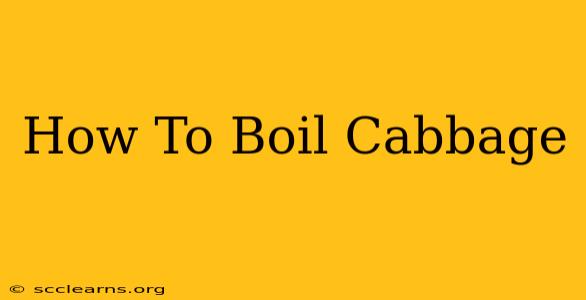Boiling cabbage is a surprisingly versatile cooking method, resulting in tender, flavorful leaves perfect for various dishes. Whether you're aiming for a simple side dish or a key ingredient in a hearty stew, mastering the art of boiling cabbage ensures optimal texture and taste. This guide provides a step-by-step approach to achieving perfectly boiled cabbage every time.
Preparing Your Cabbage for Boiling
Before you even start boiling, proper preparation is key to success. Here's how to prep your cabbage:
- Choose your cabbage: Select a firm, dense head of cabbage with crisp, undamaged outer leaves. Avoid cabbages with bruises or soft spots.
- Wash thoroughly: Rinse the cabbage under cold running water to remove any dirt or debris.
- Remove outer leaves: Discard any wilted or damaged outer leaves.
- Cut into wedges or slices: Depending on your recipe and preference, cut the cabbage into either wedges (for larger pieces) or thin slices (for quicker cooking). Smaller pieces cook faster than larger ones.
Boiling Cabbage: A Step-by-Step Process
Once your cabbage is prepped, follow these simple steps for perfectly boiled cabbage:
- Fill a pot with water: Use a pot large enough to comfortably hold the cabbage without overcrowding. Add enough water to completely submerge the cabbage.
- Add salt (optional): Adding a pinch of salt to the boiling water can enhance the flavor of the cabbage. This is entirely optional, based on your taste preferences.
- Bring the water to a boil: Place the pot over high heat and bring the water to a rolling boil.
- Add the cabbage: Gently add the prepared cabbage wedges or slices to the boiling water.
- Reduce heat and simmer: Once the water returns to a boil, immediately reduce the heat to a gentle simmer. Cover the pot.
- Cook until tender: The cooking time will vary depending on the size and thickness of your cabbage pieces. Generally, smaller pieces will take around 5-7 minutes, while larger wedges may require 10-15 minutes. Test for doneness by piercing a piece with a fork; it should be tender but not mushy.
- Drain and serve: Once cooked, remove the cabbage from the pot using a slotted spoon and drain any excess water. Serve immediately as a side dish or incorporate it into your favorite recipe.
Tips for Perfectly Boiled Cabbage
- Don't overcook: Overcooked cabbage will become mushy and lose its flavor. Aim for a tender-crisp texture.
- Add acidic ingredients (optional): A squeeze of lemon juice or a splash of vinegar at the end of cooking can brighten the flavor and prevent discoloration.
- Experiment with flavors: Add herbs and spices like bay leaves, thyme, or peppercorns to the boiling water to infuse your cabbage with additional flavor.
- Use leftover cabbage creatively: Boiled cabbage can be used in a variety of dishes, including coleslaw, soups, stews, or as a filling for dumplings.
Troubleshooting Common Problems
- Cabbage is too tough: If your cabbage is still tough after simmering, continue cooking for a few more minutes, checking frequently.
- Cabbage is too mushy: If your cabbage is overly soft, you've likely overcooked it. Reduce cooking time next time.
- Cabbage is discolored: Adding a bit of acid (lemon juice or vinegar) towards the end of cooking will help prevent discoloration.
By following these simple steps and tips, you'll be well on your way to mastering the art of boiling cabbage and enjoying this nutritious and versatile vegetable in all its delicious glory. Enjoy!

